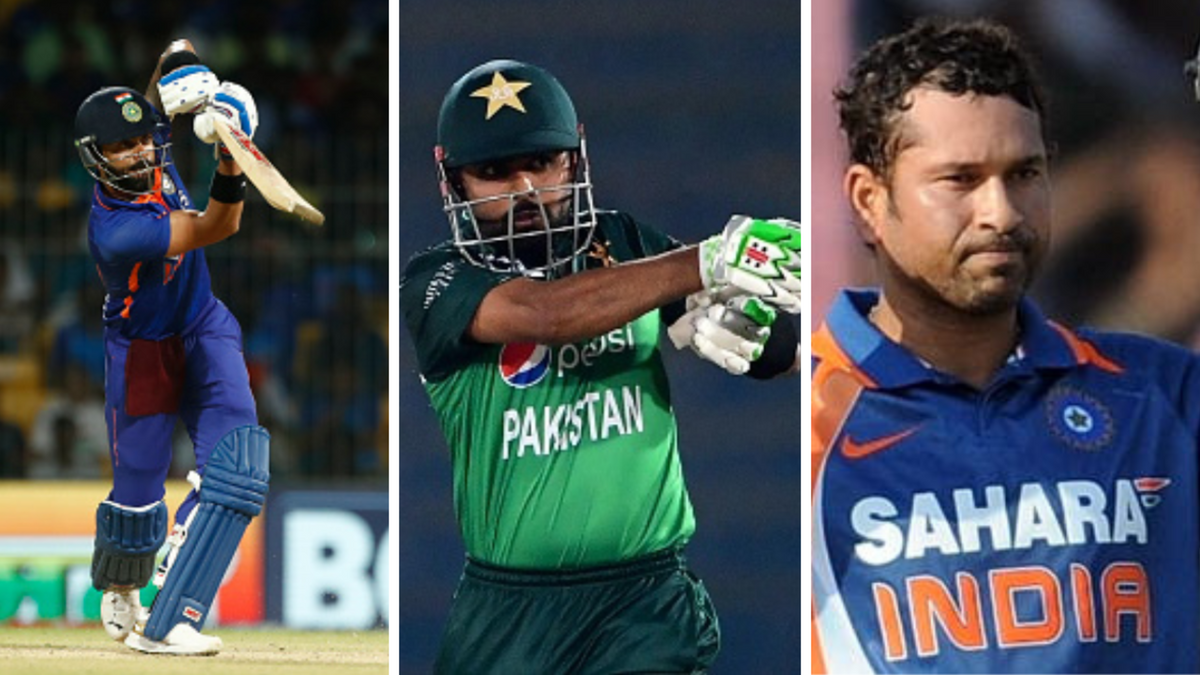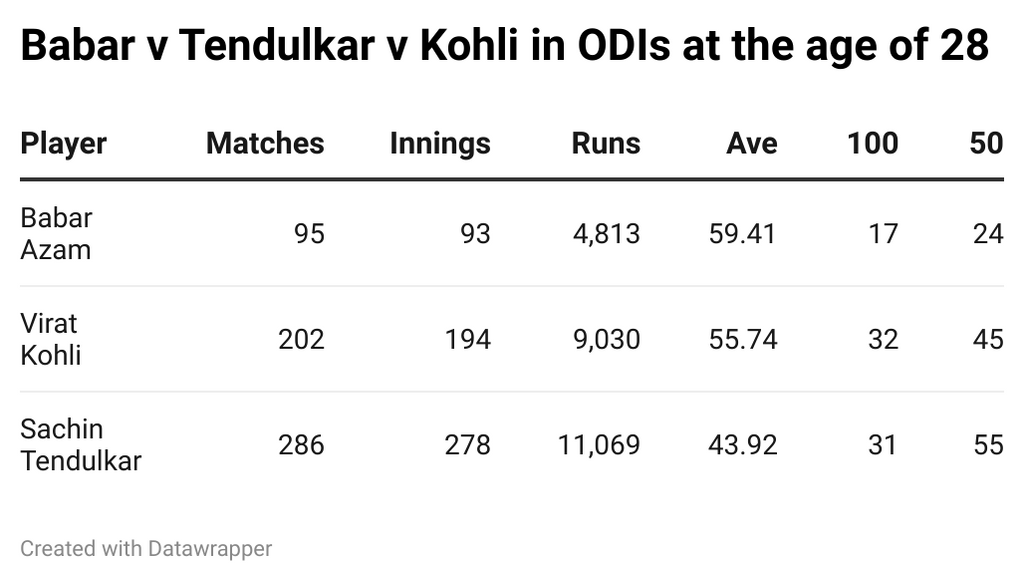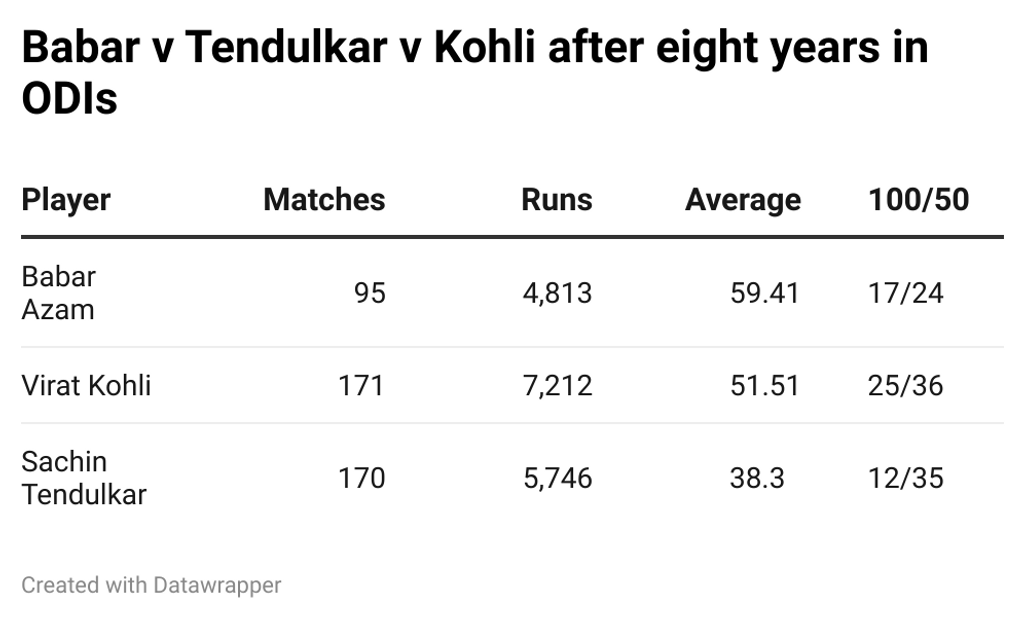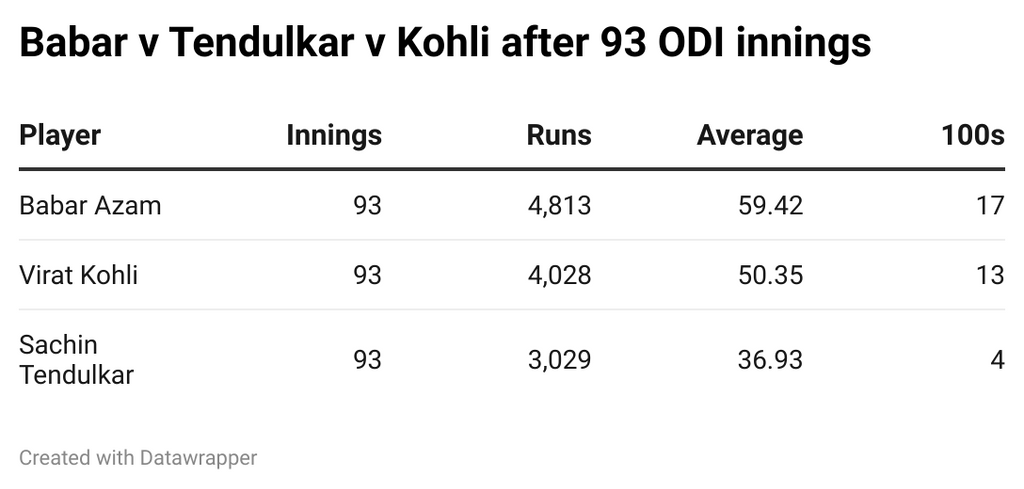
Babar Azam is nearing 100 ODI matches. Sarah Waris looks at how the Pakistan skipper ranks against ODI legends Sachin Tendulkar and Virat Kohli at the same point in their careers.
When ODI batting is considered, two men stand way out in front, in terms of consistency and prolificacy: Virat Kohli and Sachin Tendulkar. Both India batters have a number of stellar records to their name in the format, with Tendulkar ending on a mammoth 18,426 runs in 463 games, and Kohli, who continues to play ODIs, making 12,898 runs thus far. They are the only two batters to make more than 30 hundreds in the format, with 49 for Tendulkar and 46 for Kohli.
But in recent years, another has racked up runs and tons at an alarming rate. Babar Azam has made stunning progress in his eight-year career, scoring 17 hundreds with 24 fifties, and is well on track to challenge the India duo as he looks to scale similar feats.
Touted as a challenger to the ‘Fab Four’, the 28-year-old Babar has made 1,454 runs in 21 ODIs at an average of 76.52 with six hundreds since the start of 2020. No other batter from a Full Member country has made more runs or hundreds in this period, and no one else with at least 200 ODI runs averages more. His current form is an extension of his consistency as he vies for a place among the legends – how close is he to the two greatest ODI batters from India?
How Babar vs Sachin vs Kohli compare at the same age

*Babar turned 28 in October last year. We have taken into account Tendulkar’s and Kohli’s stats till they turned 29.
In terms of average, Babar is ahead. However, what is interesting is the number of games that Kohli, currently 34, and Tendulkar played before they turned 29 – more than double and triple that of Babar, respectively.
Pakistan’s calendar is not as packed as India’s, and the fact that Kohli juggled the demands of all three formats along with the IPL, maintained full fitness and averaged over 55 in ODIs is commendable. He also made 32 hundreds – getting to the landmark once every six innings. Babar has taken fewer innings for a century – he gets to three digits once every 5.4 innings.
Tendulkar, on the other hand, belonged to a different generation where run-scoring was arguably tougher and with average innings scores not as high as they are currently. Tendulkar, by virtue of debuting earlier, played nearly 300 ODIs by the age of 28, scoring a hundred every nine innings. Tendulkar also took his time to find his feet, with a promotion to opening bringing about a dramatic change in fortune. His first century came in his 79th game. From that point until his 29th birthday, his century per innings ratio is only slightly below Kohli’s.
Thus, by the age of 28 Babar surges ahead with regards to average and the number of innings taken for a hundred but a lighter schedule, which allows him more time to mend his body after tiring tours, is a factor that cannot be ignored either.
How Babar vs Sachin vs Kohli compare after the same number of years in ODIs
Tendulkar made his debut when he was 16 years old and gained huge experience in the next 12 years. Babar made his debut when he was 20 and Kohli when he was 19. When calculating the stats of the players till the age of 28, the important factor of additional years of experience on the circuit was not considered. So, we take into account the records after a certain number of years as well.
Babar has currently played close to eight years of ODI cricket, making his debut against Zimbabwe in May 2015. He averaged 38.33 in his first year before his average rose and he started getting noticed by the world. We have considered Kohli and Tendulkar’s records exactly eight years after their respective ODI debuts.

Once again, the difference in the number of games between the two India batters and Babar is evident. Tendulkar’s average was below 40 for nearly the first half of his career. Tendulkar made 12 hundreds in his first eight years – and added 37 more till he retired.
As far as Babar v Kohli is concerned, the former edges ahead as far as the average is concerned, scoring nearly 10 runs more in every game. Babar also manages a fifty-plus knock every 1.8 innings, as compared to Kohli, who took 2.8 innings for a knock of 50 or more.
In the first eight years of their careers, Babar averaged 79 at home in the 15 games that he played in Pakistan and 55.67 when touring (including neutral venues). Tendulkar averaged 45.47 at home in his first eight years, which fell to 34.61 away. Kohli, on the other hand, scored at 54.69 in India and maintained an average of 49.63 away.
In run chases, Babar’s average of 58.15 with seven hundreds in 50 innings is astounding, but Kohli takes the lead here, averaging 61.22 with 15 hundreds in the first eight years, in 91 innings. Tendulkar, on the other hand, averaged 39.01 in run chases till 18 August 1997, with five of his 12 hundreds coming in the second innings.
How Babar vs Sachin vs Kohli compare after the same number of innings

Babar has the highest aggregate after 93 innings in the history of ODI cricket. Michael Bevan has the highest batting average after 93 innings – 62.21 – and Babar is not far behind. No other batter has made more hundreds than Babar after 93 innings.
Kohli has the third-most number of centuries after 93 innings – 13 – with Hashim Amla in second place. Only five batters have made more than 4,000 runs and have an average of over 50 after 93 innings (Babar and Kohli are joined by Amla, Joe Root and Vivian Richards) and undoubtedly it is a reputed list to be a part of. The fact that Babar has managed to surpass the legends of the game speaks volumes about his potential.
Tendulkar found the going tough in his initial days as an ODI batter, but there are numerous other factors to consider when taking his feats into consideration.
Conclusion
In terms of runs and hundreds per innings, Babar is on track to match the summits of Kohli and Tendulkar, but age will be a factor. By 29, Kohli and Tendulkar had played 171 and 170 ODIs, respectively, while Babar has only 95 games to his name and will have to play catch-up. With question marks over his captaincy and the overall unpredictability that looms in Pakistan cricket, an uninterrupted career lasting for most parts of the next decade is what he needs.








